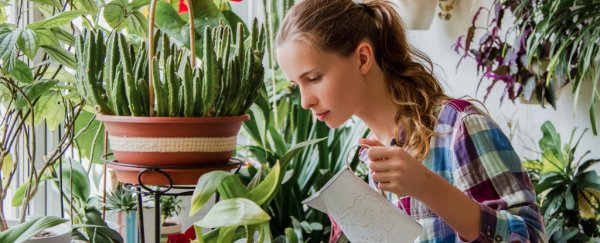Filling your house with potted plants might make you happier and more productive, but it's not going to make the air you breathe any cleaner. That is, unless you had a ludicrous number of indoor plants: somewhere between 10 and 1,000 for every square metre of your living space.
A critical review, drawing on 30 years of research, has once again found that houseplants have little - if any - real value as air removers. Using data from a dozen different studies over the years, the authors reiterate that for a normal 140 m2 house or office (1,500 ft2), you'd need 680 house plants or five per square metre to achieve the same airflow as a couple open windows.
Obviously, that's not a smart use of space. Even one plant per square metre is ineffective and impractical for most people.
If you wanted to improve air quality in your house beyond what windows, doors or a normal building's air handling system can do, you'd need roughly a hundred plants per square metre, the authors say. And nobody has the time, space or patience to accommodate that much greenery.
"This has been a common misconception for some time," says environmental engineer Michael Waring at Drexel University.
"Plants are great, but they don't actually clean indoor air quickly enough to have an effect on the air quality of your home or office environment."
The idea for this myth really took root in 1989, when NASA conducted a study on plants to see if they could filter cancer-causing chemicals on space stations.
The research only got so far as placing a plant in an air-tight chamber smaller than a cubic metre, although the results were remarkable. Within a day, the authors reported up to 70 percent of the toxic pollutants in the air had been removed by the plants.
But a small sealed chamber is very different to a real indoor environment in a big building. Over time, the NASA study and subsequent research has been largely taken out of context.
In a normal building, the authors argue, stale indoor air is continuously being replaced with fresh air from the outdoors, orders of magnitude faster than the chamber experiments.
The authors demonstrated this by taking 196 experimental results and translating them into clean air delivery rates (CADR). Using this metric, they calculated that for nearly all the studies, the rate at which plants cleaned volatile organic compounds (VOCs) from the air was so slow as to be irrelevant.
"The CADR is the standard metric used for scientific study of the impacts of air purifiers on indoor environments," says Waring, "but many of the researchers conducting these studies were not looking at them from an environmental engineering perspective and did not understand how building air exchange rates interplay with the plants to affect indoor air quality."
While a few of the studies did measure real indoor environments, Waring and Cummings say the equipment they used was prone to inaccuracies and they used unrealistically high concentrations of toxic pollutants. What's more, absolutely none of them controlled or measured the outdoor air exchange rate.
"Only two publications were found that not only acknowledge these issues, but explicitly refute the notion that common houseplants improve indoor air quality," they write.
These two studies were also written by indoor air and building scientists. And even in the 2009 review, their conclusions were much the same as now.
"[A]lthough ventilation dominates the VOC removal processes in virtually all real world buildings, ventilation was not measured in any of these studies," they wrote at the time.
"It is not possible to obtain meaningful quantitative results of pollutant removal in a field study without also measuring ventilation rates. The ventilation rate variability in most buildings is simply too large a confounder."
A decade later, Cummings and Waring are in strong agreement. In a building with an extremely low air flow and under the most generous CADR assumptions, they found one potted plant per square metre might achieve 20 percent effectiveness. But that number quickly falls when the air exchange rate is changed even a little bit.
That's not to say we shouldn't keep doing research on plants in sealed chambers. Finding out how plants filter indoor VOCs could potentially be useful for 'biopurifiers', which mechanically pull air through a porous substrate for plants.
Still, it's important that researchers and the media don't extrapolate such findings to real world environments. Filling your house with plants may make you feel great, but you don't have to do it just to make an impact on air quality. Especially when you consider some plants actually release VOCs, spores and other bioparticles.
"This is certainly an example of how scientific findings can be misleading or misinterpreted over time," Waring says.
"But it's also a great example of how scientific research should continually reexamine and question findings to get closer to the ground truth of understanding what's actually happening around us."
The study was published in the Journal of Exposure Science & Environmental Epidemiology.
